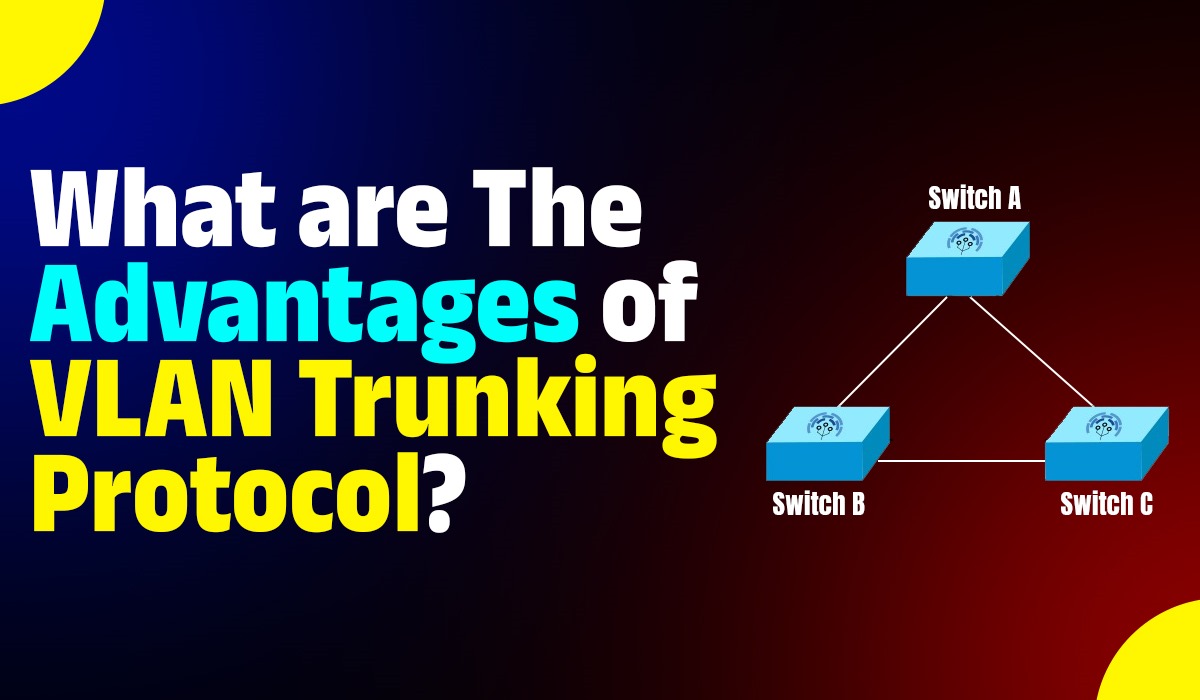What are the Advantages of VLAN Trunking Protocol?
 PyNet Labs
PyNet Labs 
Introduction
In modern networking, efficient management of VLANs (Virtual Local Area Networks) is crucial for the performance and scalability of large networks. One of the key protocols that aid in VLAN management is the VLAN Trunking Protocol (VTP). VTP simplifies the management of VLAN configurations across a network. This article will delve into the advantages of the VLAN Trunking Protocol and why it is a vital tool for network administrators.
Understanding VLAN Trunking Protocol
VLAN Trunking Protocol(VTP) is a Cisco-proprietary protocol used to manage VLAN configurations across multiple switches. VTP reduces the complexity and potential for errors by automating the propagation of VLAN information throughout a network. This ensures that VLAN configuration changes made on one switch are consistently applied to all other switches in the network.
Advantages of VLAN Trunking Protocol
- Simplified VLAN Management
One of the primary advantages of VTP is the simplification of VLAN management. Without VTP, administrators must manually configure VLAN information on each switch, which can be time-consuming and prone to errors. VTP automates this process by allowing VLAN configurations to be propagated automatically across all switches in the VTP domain. This ensures that all switches have a consistent VLAN configuration, simplifying network management.
- Centralized VLAN Configuration
VTP allows for centralized VLAN configuration, meaning changes can be made from a single switch and propagated throughout the network. This centralized approach reduces administrative overhead and ensures that VLAN configurations are uniform across all switches. It also makes it easier to implement changes quickly, improving network agility and responsiveness to new requirements.
- Improved Scalability
As networks grow, managing VLAN configurations manually becomes increasingly challenging. VTP enhances scalability by enabling the automatic distribution of VLAN information to new switches as they are added to the network. This ensures that new switches are immediately configured with the correct VLAN information, reducing setup time and minimizing the risk of misconfigurations.
- Consistent VLAN Information
Consistency in VLAN configurations is crucial for network stability and performance. VTP ensures that all switches in the network have the same VLAN information, preventing issues that can arise from mismatched configurations. This consistency helps in avoiding network loops, broadcast storms, and other issues that can degrade network performance.
- Reduced Configuration Errors
Manual configuration of VLANs on multiple switches increases the likelihood of errors. These errors can lead to network issues that are difficult to diagnose and resolve. VTP minimizes configuration errors by automating the process of VLAN propagation, ensuring that all switches receive accurate and consistent VLAN information. This reduces the risk of human error and enhances overall network reliability.
- Enhanced Network Flexibility
VTP provides enhanced network flexibility by allowing administrators to easily add, delete, or modify VLANs. Changes made on one switch are automatically propagated to all switches in the VTP domain, making it easy to adjust the network to meet changing needs. This flexibility is particularly beneficial in dynamic environments where VLAN configurations may need to change frequently.
- Efficient Use of Resources
By automating VLAN management, VTP helps efficiently use network resources. Administrators can focus on other critical tasks instead of spending time on repetitive VLAN configuration updates. Additionally, VTP reduces the need for extensive documentation and manual verification of VLAN configurations, leading to more efficient network operations.
- Simplified Network Troubleshooting
When VLAN configurations are consistent across all switches, troubleshooting network issues becomes more straightforward. VTP ensures that VLAN information is uniform, making it easier to identify and resolve issues related to VLAN misconfigurations. This streamlined troubleshooting process can lead to faster resolution of network problems, minimizing downtime, and improving network availability.
- Seamless Integration with Existing Infrastructure
VTP integrates seamlessly with existing Cisco network infrastructure. Since it is a Cisco-proprietary protocol, it is fully compatible with Cisco switches and routers, allowing for easy deployment and management. This seamless integration helps leverage existing investments in Cisco technology and enhances the network's overall efficiency.
- Support for Large-Scale Networks
In large-scale networks, managing VLANs manually is impractical. VTP supports large-scale deployments by providing a robust mechanism for automatic VLAN propagation. This support ensures that even the largest networks can maintain consistent VLAN configurations with minimal administrative effort, making VTP an essential tool for enterprise networks.
- Security Considerations
VTP also includes security features that help protect the integrity of VLAN configurations. VTP domains can be password-protected, ensuring that only authorized devices can join the VTP domain and receive VLAN information. This security measure helps prevent unauthorized changes to VLAN configurations, enhancing the overall security of the network.
- Version Control
VTP supports different versions, each offering additional features and improvements over previous versions. This version control allows network administrators to choose the appropriate VTP version based on their specific network requirements and capabilities. Upgrading to newer VTP versions can provide enhanced functionality and security features, further optimizing VLAN management.
FAQs - Frequently asked question
What is VLAN Trunking Protocol (VTP)?
VTP is a Cisco-proprietary protocol used to manage VLAN configurations across multiple switches, simplifying VLAN management and ensuring consistency.
How does VTP improve network scalability?
VTP automatically propagates VLAN information to new switches, reducing setup time and ensuring consistent configurations across a growing network.
Can VTP help in reducing configuration errors?
Yes, VTP automates VLAN propagation, minimizing the risk of human error and ensuring consistent VLAN information across all switches.
Is VTP compatible with non-Cisco devices?
VTP is a Cisco-proprietary protocol and is fully compatible with Cisco switches and routers, but it may not be supported by non-Cisco devices.
What are the security features of VTP?
VTP domains can be password-protected, ensuring that only authorized devices can join and receive VLAN information, enhancing network security.
Conclusion
The VLAN Trunking Protocol (VTP) offers numerous advantages for managing VLAN configurations in a network. From simplifying VLAN management and improving scalability to ensuring consistent VLAN information and reducing configuration errors, VTP is an invaluable tool for network administrators. By leveraging VTP, organizations can enhance network efficiency, reliability, and security, making it a critical component of modern network management.
Subscribe to my newsletter
Read articles from PyNet Labs directly inside your inbox. Subscribe to the newsletter, and don't miss out.
Written by

PyNet Labs
PyNet Labs
PyNet Labs is a reputable networking training institute that provides a variety of courses to both students and working professionals. The main aim of PyNet Labs is to make higher education more affordable so that more people can achieve their dream jobs.